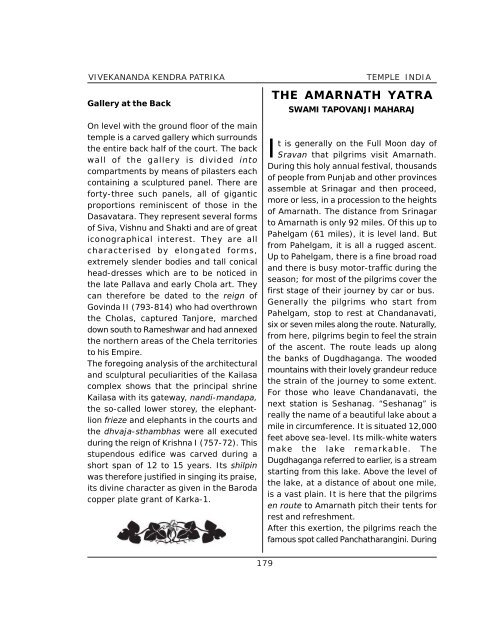Temples In India-1.pdf - Vivekananda Kendra Prakashan
Temples In India-1.pdf - Vivekananda Kendra Prakashan
Temples In India-1.pdf - Vivekananda Kendra Prakashan
Create successful ePaper yourself
Turn your PDF publications into a flip-book with our unique Google optimized e-Paper software.
VIVEKANANDA KENDRA PATRIKAGallery at the BackOn level with the ground floor of the maintemple is a carved gallery which surroundsthe entire back half of the court. The backwall of the gallery is divided intocompartments by means of pilasters eachcontaining a sculptured panel. There areforty-three such panels, all of giganticproportions reminiscent of those in theDasavatara. They represent several formsof Siva, Vishnu and Shakti and are of greaticonographical interest. They are allcharacterised by elongated forms,extremely slender bodies and tall conicalhead-dresses which are to be noticed inthe late Pallava and early Chola art. Theycan therefore be dated to the reign ofGovinda II (793-814) who had overthrownthe Cholas, captured Tanjore, marcheddown south to Rameshwar and had annexedthe northern areas of the Chela territoriesto his Empire.The foregoing analysis of the architecturaland sculptural peculiarities of the Kailasacomplex shows that the principal shrineKailasa with its gateway, nandi-mandapa,the so-called lower storey, the elephantlionfrieze and elephants in the courts andthe dhvaja-sthambhas were all executedduring the reign of Krishna I (757-72). Thisstupendous edifice was carved during ashort span of 12 to 15 years. Its shilpinwas therefore justified in singing its praise,its divine character as given in the Barodacopper plate grant of Karka-1.TEMPLE INDIATHE AMARNATH YATRASWAMI TAPOVANJI MAHARAJIt is generally on the Full Moon day ofSravan that pilgrims visit Amarnath.During this holy annual festival, thousandsof people from Punjab and other provincesassemble at Srinagar and then proceed,more or less, in a procession to the heightsof Amarnath. The distance from Srinagarto Amarnath is only 92 miles. Of this up toPahelgam (61 miles), it is level land. Butfrom Pahelgam, it is all a rugged ascent.Up to Pahelgam, there is a fine broad roadand there is busy motor-traffic during theseason; for most of the pilgrims cover thefirst stage of their journey by car or bus.Generally the pilgrims who start fromPahelgam, stop to rest at Chandanavati,six or seven miles along the route. Naturally,from here, pilgrims begin to feel the strainof the ascent. The route leads up alongthe banks of Dugdhaganga. The woodedmountains with their lovely grandeur reducethe strain of the journey to some extent.For those who leave Chandanavati, thenext station is Seshanag. “Seshanag” isreally the name of a beautiful lake about amile in circumference. It is situated 12,000feet above sea-level. Its milk-white watersmake the lake remarkable. TheDugdhaganga referred to earlier, is a streamstarting from this lake. Above the level ofthe lake, at a distance of about one mile,is a vast plain. It is here that the pilgrimsen route to Amarnath pitch their tents forrest and refreshment.After this exertion, the pilgrims reach thefamous spot called Panchatharangini. During179
















